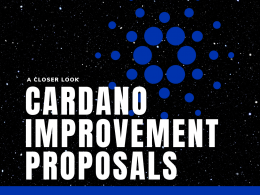Cardano is ready to receive DApps since mid-September, when it executed its Hard Fork Alonzo, bringing the new Goguen era to its fullness, and thus the programmability on its blockchain is a reality .
The different developers are adjusting their codes and processes for the launches, which are expected in weeks, for several of them, according to their road maps.
DeFi platforms, both DEX and Lending, will be the initial stars that will bring an increase in blockchain activity.
Within the needs of a varied ecosystem, stablecoins cannot be missing, as a unit of account and medium of exchange, with non-volatile prices in their fungible tokens, in order to develop financial and commercial activities, in short, the long-awaited use in Cardano .
In a previous article, I explained the different stablecoins in the industry, and their characteristics, and now it is the turn of those of the Cardano ecosystem.
AgeUSD
Is a decentralized stablecoin issuance protocol. Created in the alliance of IOG, EMURGO and ERGO, and is developed on the Ergo blockchain.
With this protocol,has been created SigmaUSD, the first stablecoin in the Cardano-Ergo ecosystem, where everyone can mint SigUSD (which is pegged to the US dollar) or mint SigRSV, providing the reserve for the platform. Through smart contracts, people can keep USD backed by ERGs (Ergo’s native currency), and earn commissions by locking their ERG as reserve capital.
SigUSD is backed by reserves and not collateral debt positions. A reserve-backed model is a superior option for preventing cascading liquidations during extreme volatility. This is accomplished by locking the reserve tokens to protect the linked value.
This was the first algorithmic stablecoin, implemented on a UTXO-based ledger in the first quarter of 2021. It had a 1% fee for buy or sell operations and an oracle that updated the exchange rate every hour. This initial release was subject to a reserve drain attack by an anonymous user who owned a large amount of ERG. The attack was ultimately unsuccessful and the attacker is estimated to have lost $ 100,000.
DJED
The teams at IOG, ERGO and EMURGO have been working on the implementation of the algorithmic contract of the Djed stablecoin in early 2021 to test different models.
Djed is a stablecoin, based on an algorithmic design. It uses smart contracts to ensure price stabilization and that the coin is useful for decentralized financial operations (DeFi). It works by maintaining a reserve of base currencies, and minting and burning stablecoins and reserve currencies.
The contract maintains the peg of the stablecoins to a target price by buying and selling the stablecoins, using the reserve and charging fees, which are accumulated in the reserve. The ultimate beneficiaries of this income stream are the reserve currency holders. who increase the reserve with funds assuming the risk of price fluctuation.
Due to the attack on SigmaUSD, and to further discourage them, Minimal Djed was implemented with a version where the rate was set at 2%, the Oracle is updated every 12 minutes and each update from Oracle can change the price at most by 0.49% , unless the price difference is greater than 50%. This provides increased resistance against reserve drain attacks.
There are two versions of Djed:
- Minimal Djed: This version is designed to be as simple, intuitive and straightforward as possible, without compromising stability.
- Extended Djed – This more complex version provides some additional stability benefits. The main differences are the use of a continuous pricing model and dynamic rates, to further incentivize the maintenance of the reserve index at an optimal level.
Furthermore, Djed has also been implemented by the IOG team in Solidity. They have created a version that uses the native Ethereum blockchain currency as the base currency, and another version that uses any ERC20 compliant token as the base currency. So far, these implementations have been done on the Binance Smart Chain, Avalanche’s Fuji, Polygon’s Mumbai, Ethereum’s Kovan, Ethereum’s Rinkeby and RSK’s testnets.
The research paper: Djed: A Formally Verified Crypto-Backed Pegged Algorithmic Stablecoin
COTI will issue Minimal Djed and Extended Djed, thus occupying a leading place in the Cardano ecosystem. COTI’s mainnet went live in June 2019 and announced multiple partnerships with crypto-related projects like Simplex. In the months that followed at the end of 2019, COTI announced AdaPay, as one of the many applications that are part of COTI’s universal payment system.
Unlike cryptocurrencies that use standard dags, COTI consists of multiple dags, which allow multiple tokens to be issued. COTI’s multi-dag infrastructure has a novel consensus mechanism called Proof of Trust (PoT), where the validity of a transaction is determined by its trust score, and the trust score of a transaction is initially derived from the identity of the user who performs the transaction.
dUSD
Ardana is a DeFi hub built on the Cardano blockchain, as a decentralized stablecoin ecosystem.
dUSD will be pegged to the US dollar and verifiably backed by an on-chain guarantee. Users will be able to generate multiple stablecoins, with dUSD being the main stablecoin at launch.
The stablecoin will be overcollateralized with native Cardano assets on the chain, which facilitate decentralized lending and exchange, and will allow highly efficient capital trading between stablecoins and assets.
Ardana Vaults will allow users to generate stablecoins against the collateral of native Cardano tokens deposited in their vaults, through unique smart contracts known as Collateralized Debt Positions (CDP).
Ardana Vaults is a non-custodial and non-permissioned protocol, in which all generated stablecoins will be backed by an excess of collateral, preserving value even in volatile markets. There will always be more coins in the vault than in circulation, so the stablecoin will be able to withstand large price swings in the market.
A Gold-Backed Stablecoin Project
MELD is a DeFi lending protocol, which is preparing to launch a network of gold-backed stablecoins.
Ken Olling, co-founder and president of MELD, says that “the goal here is simplicity and clarity. The gold will be stored in a vault, it will be tokenized and then it will be fractionated and divided so that we can sell it . “
David Taylor, Marketing Head of the Cardano Foundation, shared the announcement on Twitter.
You can see more information on MELD – Tingo Partnership
Final Thoughts
The Cardano ecosystem will benefit from the wealth of developments on native tokens that can be designed, but also from the interoperability for which it was intended.
The first use of stablecoins will be financial, for the lending industry and of decentralized token exchanges, but then, with the maturation of the industry and adoption, the demand for use will be as broad as the global economy itself.
Trade in goods and services, decentralized digital identity and governance of organizations (DAO) will prescribe the qualities of money, as a unit of account and medium of exchange, with predictability and uniformity of value over time.
link











Unfassbar furchtbar zu lesen. Ich meine von diesen Google Translate Artikeln gibt es genug, aber dieses geschwobbel und versuchte hochtrabende Geschwätz, einfach nur furchtbar.